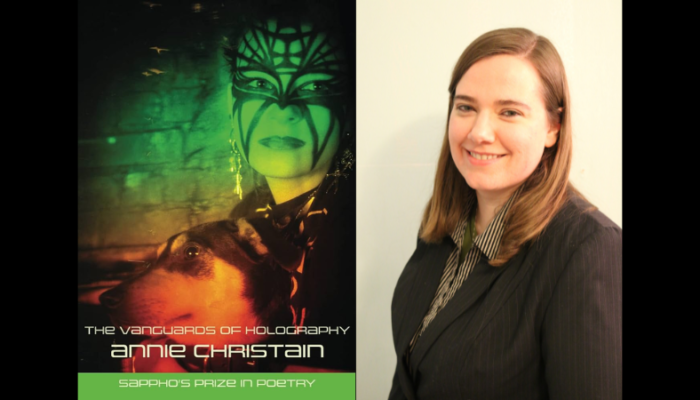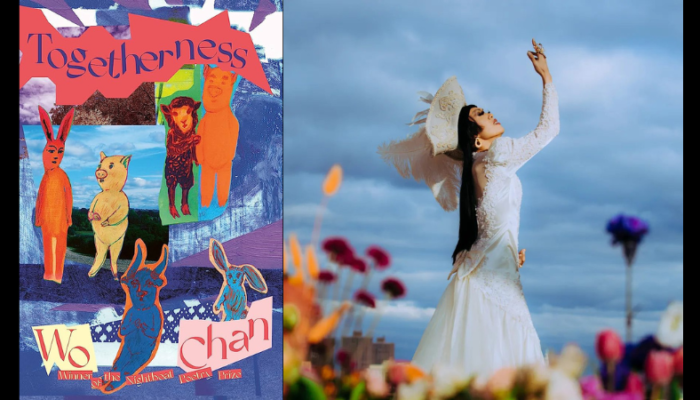Through The Six Inch Valley
2001
I grow in my armpit hair, my leg hair, my arm hair. The only thing I shave is my face. I’m on the train and I take off my sweater. There’s a man—boy really—with a group of his friends, all boys. He sees. He’s shocked. He and his friends start talking loudly about their fathers, their father’s armpit hair. They’re doing it to mock me.
When I get off the train, I have to walk through them. I don’t look at them. There seems to be so many of them.
I get off the train and put my sweater back on. I can’t stop shaking.
I can’t remember where I was going at the time.
2005
My first lover, Yasmin, was a transwoman who often wore pants and almost always paired them with tops that flowed past her hips, black converse sneakers. She often got called a faggot.
When I first met her, she gave me a single flower, a carnation, I think.
I can’t remember exactly what I looked like then—I don’t have many pictures from that time. I know my hair was long enough to be curly, probably shoulder length, and I wear makeup sometimes, when I feel like it. On our second date, I wore a green v-neck shirt. It was spring.
1990
My father tells me he stood next to two women in church so he wouldn’t have to hold hands with a man.
1994
I’m fourteen, and I ask my mother how to put make-up on. It’s a few weeks before she’s going to die. She shows me, even though she never wears much make-up, but she’d been painting in some of the places where she had lost hair—her eyebrows had been gone for years. She had lost the natural flush to her face that I also have, but she doesn’t paint that over. I can’t remember when it faded. Maybe during the chemotherapy. She had two wigs: one that looked like the hair she lost (a short haircut, the wig was brown, but even had gray hairs threaded into it, to more perfectly match her former hair); the other, an ash blonde bob cut; she got that one for free from some make-over for cancer patients. When she sat in front of me in the car, it looked like she had been replaced with another woman.
1999
In college, my friend Colleen said, “we should shave your head.” We’re in the dorm of her college. I was sitting on the floor. Ok, I said. I remember thinking that I just needed to do something, and this might as well be it. It wasn’t a good year. I spent a lot of time on campus sitting on benches alone, smoking or driving around, smoking.
I don’t remember Colleen shaving my head, but I remember the feeling after: people’s hands shivering over my head again and again. I had hoped that having a shaved head would make me look tougher, but people call me peach fuzz.
When my hair grew in, I dyed the inch of it, wore it in spikes. That year, I had a uniform: band t-shirt (usually black), cargo pants, and a soft wool cardigan (red, purple or blue).
1996
All through high school, I wear a uniform: red and green plaid kilt, white blouse, green wool cardigan that never gets soft no matter how much you wash it. Catholic school clothes all seem to model themselves after the burlap some saint wore to torture herself.
We all roll our skirts; the higher you roll, the more revered you are. Everyone wears boxers under their skirts. Men’s boxers. This was before everything was safely labeled “boyfriend.”
Once the principal, a nun, makes an announcement after mass, which was held on the stage in the auditorium, the same place as the school plays. “Girls, you have to stop rolling your skirts. Thighs are not attractive, ladies, who are you trying to impress?”
1998
I use cover-up over my whole face to make it paler, and then blush over that. Thick liquid eyeliner. I practice. I steady myself for the application.
I dye my hair red again and again, stripping it and dying each time, it never seems red enough. It’s only now that I see from looking at the pictures how red my hair was. Though part of me wonders if it was a trick of the light, of photography.
1995
When I’m fifteen, Colleen informs me that I have too much hair on my face. She says her mother told her it was sad, and probably because my mother was dead, and so I didn’t have a mother to tell me. She takes me to a nail salon that smells like burnt plastic to get my beard waxed. The woman doing it touches my face, as if in astonishment. “So much,” she says. I try not to flinch. I can’t remember the last time anyone touched my face.
2014
During the end of a relationship I had with a man, one of the last blow-outs is about the hair on my face. He hates that I don’t care if some of it shows. If it’s not perfectly invisible.
He says people will judge me.
I say, well, fuck them then.
Then, the truth: he doesn’t like it.
1997
I don’t know how to wax, and I don’t read the directions. I pour the wax directly on my arms. Then I realize that I’ve made myself into a sculpture I can’t get out of. But I have to. The layer’s so thick. I start pulling away the pieces in chunks with my fingers; with it comes hair, skin. I bleed.
2002
I go to get my hair cut. I say: I want it short. Like a boy.
2012
My eyes linger too long on a group of genderqueer teenagers (with admiration; they’re all lipstick and piercings and gloriously illegal tattoos). They yell at me, mock what I’m wearing, thinking my gaze was one of judgment. I had forgotten what I look like: some straight woman. I was on the subway and they were on the platform. The train doors closed on us before I could speak. I couldn’t be upset with them. I know what it’s like to feel like you have to be ready for a fight.
2011
I have a tattoo (or tattoos, depending on how you’re looking at it): the names of the muses in a spiral around a purple gay pride triangle. Calliope, the muse of epic poetry, was the muse that hurt the most.
When I go to Fire Island with the man I’m dating I feel strange when I expose my tattoo: I don’t know how to negotiate what people see and what my life is.
2002
My friend Emily calls herself a drag queen trapped in a woman’s body. She has closets full of clothes, mostly vintage. I marvel over her jewelry, her make up. She teaches me the word “ablutions.”
She says everyone should be allowed this—to wear these clothes, paint their faces. She’s an artist.
I hadn’t been wearing make-up, but I start to play again. It feels fun with her. I buy a pair of garnet earrings hung on little hooks. One of the healing properties of the garnet is that it’s meant to help someone search for something even if what they find is unsettling or painful, but I don’t know that at the time.
2005
Emily and I take Yasmin bra shopping. It’s her first time, and she’s nervous and gives me money to pay for her even though we’re all in the dressing room together, and the clerk knows what’s happening.
But we get into the ritual: strapping on the lace, adjusting the wires so they don’t poke us in the ribs, pulling up satin straps. Emily, always the teacher, is trying to tell Yasmin what will be the most flattering. She picks out sizes that she think will work.
Yasmin doesn’t know she’s my first—I haven’t lied, but I haven’t told the truth either.
2011
I feel like I’m lying when I refer to my partner as “he.” Not because he isn’t a he, but because it makes part of me invisible. I try to move my sentences around, manipulate syntaxes, bend everything around to avoid pronouns. But when I’m tired, I just say “he.”
2000
My first close male friend is a gay man, and I ask him to help me learn how to tie a tie. “I can only do it on myself,” he says, “not on someone else.”
He takes the tie from me and puts it around his neck. Untied, it looks like a long ribbon—blue and shiny. He holds the skinnier part still. “This guy stays in the same place and doesn’t move, but the other guy”—he holds the thicker part— “goes around. Then you put it in the hole you make.” He pulls the tie into place.
We laugh about the hole part.
2014
I finally shave my legs again for the first time in months. I like the feeling of removing the hair because it makes them more sensitive. But I’m also tired.
When I do it, I have to reach down and take off all the hair clumps that eclipse the drain again and again. My back aches from doing it.
I don’t like that I have to hide my hairy legs if I don’t want to be stared at. That I always miss patches. That it’s too hard to get all of it off.
2012
I buy a tie, sort of for myself, sort of for my then fiancé, a man. I buy it from my friend Julia’s husband, Dan, while we’re at a Flea Market. It has blue and orange stripes and he’s silk-screened it with a pair of scissors along “cut here” lines, as if it comes printed with instructions on how to destroy it, just in case.
I can’t remember how to tie it.
“You guys, I can’t believe I forgot. I used to wear ties all the time.”
“That tie knows you’re marrying a man,” Julia jokes.
We laugh.
“I can only do it on myself,” Dan says.
He does it twice and I watch, trying to remember how it’s done. Like me, Dan’s also half Irish and half Italian, a loud Aquarius. His mother’s also dead.
When he’s done, he loosens it, and takes it off, putting it on me ceremoniously.
I wear it, still loose, as Julia and I look around at the Flea Market.
The only other thing I buy that day is a tiny embroidered day of the dead skull.
2014
On the subway, I keep listening to Springsteen’s song, “I’m on Fire.” I try to listen to things like I haven’t heard them already. The line: “It’s like someone took a knife baby edgy and dull and cut a six inch valley through the middle of my soul.”
That the soul is a mountain, and desire changes the landscape. And there’s no going back from that.
2001
I keep wearing clothes that are too hot for the summer class I’m in: a blue polyester button down shirt over an A-shirt (I won’t call it a wife-beater); a tie over that, knotted at my throat; jeans; converse sneakers. I meet Emily in this class and she will later become my best friend, and she’ll tell me what I almost forgot: how I’d do a kind of strip-tease when I get too hot: first, loosen the tie, then untie the tie, then unbutton the shirt, then take the button down shirt off and so I’d be sitting there with the A-shirt on, and I’m sure everyone could see my bra, but I was too hot to care. At least my hair was short, so that kept me cool.
2014
It always feels like I’m lying a bit. I like to tell people: I used to have a shaved head. They’re always shocked.
But I want people to know: these aren’t fixed landscapes, but sand-dunes that slowly shift from one position to another, like bodies moving between different stages of sleep and waking.
2013
My dad has both hips replaced. I call him while he’s on painkillers. I can tell because it doesn’t sound like him. His voice has all these soft edges. He talks about my mother, something about missing the funeral of a friend when she was sick.
“You never come to visit,” he says. I know he probably won’t remember anything he’s saying.
Now, he sits in front of the t.v. most of the time, on a heating pad, because nothing, not even having both hips replaced with steel, can make him flexible. He watches people yell at each other on Fox News while in the kitchen, my step-mother tells me she has no idea what he’s thinking half the time. She’s trying to get used to him, to his silence, even after the decade they’ve spent together. She comes from a huge, loud, Irish family. I like her family more than mine, than my father’s. When her husband died, her family helped raise her son.
“I tell him that, to me, not talking, means you’re angry. But I know it doesn’t mean that to him,” she says.
2014
In the middle of writing this, I try on some new make-up. I’m upset that I’ve forgotten how to put on liquid eyeliner (I bought it in blue), and I’ll have to learn again. I wear make-up sometimes, but not always, and I often go long stretches wearing none, or just some lip stain.
I try on some of the make-up I can remember how to put on, though I get nervous, thinking that I’m doing it wrong. I want to practice since I forgot to buy something to remove the make-up.
2014
I’m going to get a branch of forget-me-nots tattooed on my wrist. The one I write with. I was thinking of it in part for the memory of my dead. But I’m remembering more than that. In the stem, I’ll inscribe the line from the Roethe poem, “The Waking,” that I’ve loved since I first read it when I was nineteen, but that’s become more and more of a mantra:
“I learn by going where I have to go.”




